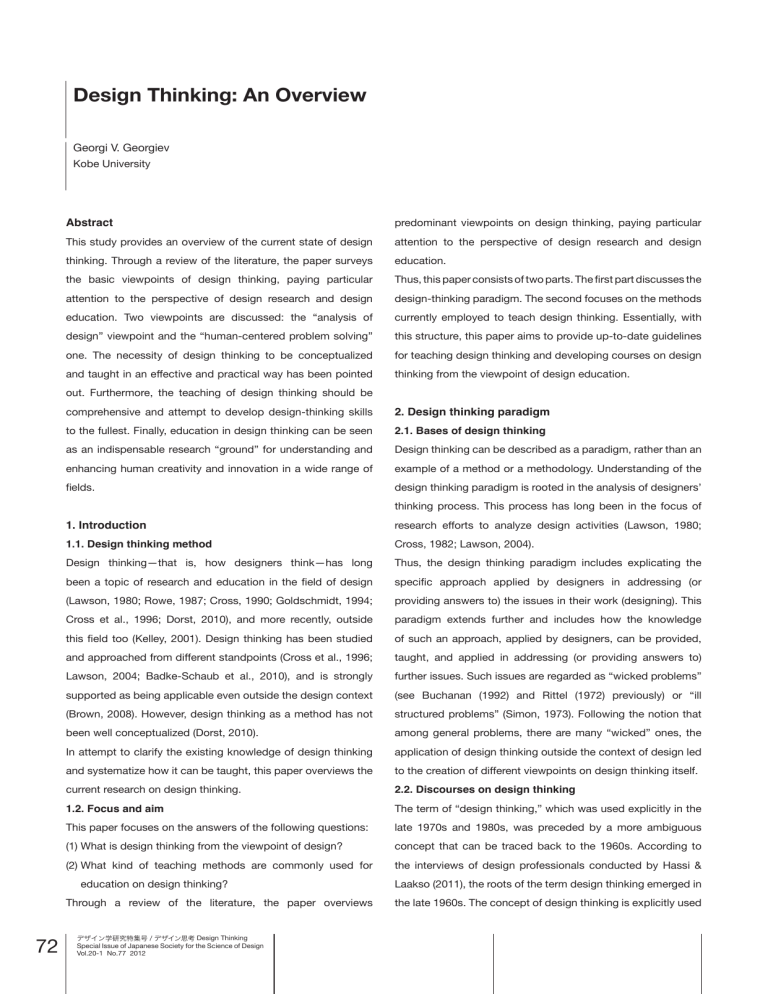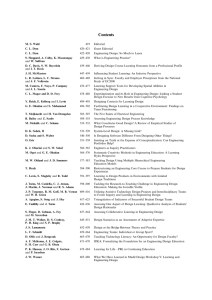DesignThinkingAnOverview
advertisement

Design Thinking: An Overview Georgi V. Georgiev Kobe University Abstract predominant viewpoints on design thinking, paying particular This study provides an overview of the current state of design attention to the perspective of design research and design thinking. Through a review of the literature, the paper surveys education. the basic viewpoints of design thinking, paying particular Thus, this paper consists of two parts. The first part discusses the attention to the perspective of design research and design design-thinking paradigm. The second focuses on the methods education. Two viewpoints are discussed: the “analysis of currently employed to teach design thinking. Essentially, with design” viewpoint and the “human-centered problem solving” this structure, this paper aims to provide up-to-date guidelines one. The necessity of design thinking to be conceptualized for teaching design thinking and developing courses on design and taught in an effective and practical way has been pointed thinking from the viewpoint of design education. out. Furthermore, the teaching of design thinking should be comprehensive and attempt to develop design-thinking skills 2. Design thinking paradigm to the fullest. Finally, education in design thinking can be seen 2.1. Bases of design thinking as an indispensable research “ground” for understanding and Design thinking can be described as a paradigm, rather than an enhancing human creativity and innovation in a wide range of example of a method or a methodology. Understanding of the fields. design thinking paradigm is rooted in the analysis of designers’ thinking process. This process has long been in the focus of 1. Introduction research efforts to analyze design activities (Lawson, 1980; 1.1. Design thinking method Cross, 1982; Lawson, 2004). Design thinking—that is, how designers think—has long Thus, the design thinking paradigm includes explicating the been a topic of research and education in the field of design specific approach applied by designers in addressing (or (Lawson, 1980; Rowe, 1987; Cross, 1990; Goldschmidt, 1994; providing answers to) the issues in their work (designing). This Cross et al., 1996; Dorst, 2010), and more recently, outside paradigm extends further and includes how the knowledge this field too (Kelley, 2001). Design thinking has been studied of such an approach, applied by designers, can be provided, and approached from different standpoints (Cross et al., 1996; taught, and applied in addressing (or providing answers to) Lawson, 2004; Badke-Schaub et al., 2010), and is strongly further issues. Such issues are regarded as “wicked problems” supported as being applicable even outside the design context (see Buchanan (1992) and Rittel (1972) previously) or “ill (Brown, 2008). However, design thinking as a method has not structured problems” (Simon, 1973). Following the notion that been well conceptualized (Dorst, 2010). among general problems, there are many “wicked” ones, the In attempt to clarify the existing knowledge of design thinking application of design thinking outside the context of design led and systematize how it can be taught, this paper overviews the to the creation of different viewpoints on design thinking itself. current research on design thinking. 2.2. Discourses on design thinking 1.2. Focus and aim The term of “design thinking,” which was used explicitly in the This paper focuses on the answers of the following questions: late 1970s and 1980s, was preceded by a more ambiguous (1) What is design thinking from the viewpoint of design? concept that can be traced back to the 1960s. According to (2) What kind of teaching methods are commonly used for the interviews of design professionals conducted by Hassi & education on design thinking? Through a review of the literature, the paper overviews 72 デザイン学研究特集号 / デザイン思考 Design Thinking Special Issue of Japanese Society for the Science of Design Vol.20-1 No.77 2012 Laakso (2011), the roots of the term design thinking emerged in the late 1960s. The concept of design thinking is explicitly used by Lawson (1980) and was developed by Cross (1982) and design viewpoint and a human-centered problem solving Schön (1983). It became the title of a book by Rowe, published viewpoint, respectively. The two viewpoints and the evolution in 1987. of their understanding (definitions) are shown in Table 1. Design thinking includes at least two key viewpoints—that of Badke-Schaub et al. (2010) discusses the different viewpoints the designer (or design researcher) and that of the decision as follows: makers. Melles clarifies these viewpoints as follows: “The traditional design thinking approach has meanwhile “The term design thinking has two current meanings –the study produced a broad research history but has to cope with of the practices of working designers—the other meaning its fragmented variety of empirical results, due to a lack of refers to the human-centred ‘open’ problem solving process theoretical integration; the new view on design thinking as decision makers use to solve real world ‘wicked’ problems.” management strategy is not grounded on empirical studies (Melles, 2010, p.299) or evaluations and suffers from an ambitious and too general Further, Badke-Schaub et al. (2010) describes this difference concept. Both approaches could gain from each other in in viewpoints as the “traditional design thinking approach” and different ways.” (Badke-Schaub et al., 2010, p. 39) the “new design thinking movement.” For the purposes of the These differences in viewpoints raise the question of what is present research, we term these viewpoints an analysis of covered by the term “design thinking.” Table 1. Development of the viewpoints on design thinking Authors Analysis of design viewpoint on design thinking Human-centred problem solving viewpoint on design thinking Stewart (2011) “Strategies for addressing ‘ill-structured’ and ‘wicked’ problems; an identification originally made by thinkers within the Design Methods movement” “A tool to aid in the navigation of transition (in this case a transition in the selfunderstanding, as well as in the operative strategies, of disciplines)” Hassi & Laakso (2011) “Cognitive styles, methods of thinking and processing information” “Practices, thinking styles and mentality” Badke-Schaub et al. (2010) “The traditional design thinking approach;” “Design thinking as the as sequence of operations and structured pattern of processes” “The new design thinking movement;” “Design thinking as innovation and transformation process for: • disruptive innovation to gain competitive advantage on the global market • to design systems or dealing with abstract problems such as services • human-/user-centered” Melles (2010) “The study of the practices of working designers;” “Abductive, wicked and synthetic” “The human-centred ‘open’ problem solving process decision makers use to solve real world ‘wicked’ problems” Cross (2010) “Encompasses many forms of thinking and intelligence;” “Skilled, educated practice of designing” Dorst (2010) “Design thinking is characterized with a kind of abduction process that provide a frame for the connection of ‘how’ and ‘value’ in the equation: ’what’ plus ‘how’ leads to ‘value’, when ‘what’ and ‘how’ entities are unknown” “Providing organizations with frameworks of ‘how’ leads to ‘value’ in unknown equitation: ’what’ plus ‘how’ leads to ‘value’” デザイン学研究特集号 / デザイン思考 Design Thinking Special Issue of Japanese Society for the Science of Design Vol.20-1 No.77 2012 73 Johansson & Woodilla (2010) “Design discourse;” “The way designers think as they work” Brown & Wyatt (2010) “Aimed at consumer insights in depth. Design thinking is inherently optimistic, constructive, and experiential;” “Social challenges require systemic solutions that are grounded in the client’s or customer’s needs” Brown (2009) “A discipline that uses the designer’s sensibility and methods to match people’s needs with what is technologically feasible and what a viable business strategy can convert into customer value and market opportunity” Kelley (2006) “The Design Process specifies procedures which seek creative success through providing a client with innovative and unique design solutions to a defined project, done on rational grounds, through an agreed-upon process” Dym et al. (2005) “Design thinking reflects the complex processes of inquiry and learning that designers perform in a systems context, making decisions as they proceed, often working collaboratively on teams in a social process, and “speaking” several languages with each other (and to themselves)” Lawson (2004) “‘Framing’ process is an important and central feature of design thinking;” “‘Moving’ phase of design thinking;” Memory has role in understanding design thinking Taura et al. (2002) Design activities beyond “framework of problem solving;” problem-solving process includes “Awareness of the problem, Suggestion, Development, Evaluation, and Conclusion” Kelley (2001) 74 “Management discourse;” “Method for innovation and creating value” “Continuously refined methodology” comprising the steps: “Understand, Observe, Visualize, Evaluate and refine, and Implement” Oxman (1999) “Thinking processes employing both visual and conceptual knowledge;” “Fundamental dialectic process of design thinking;” “Emergence of conscious access to knowledge structures;” “The interaction between visual and conceptual content in global strategies of design thinking” Buchanan (1992) “Design thinking is wicked problem approach;” “Design problems are “indeterminate” and “wicked” because design has no special subject matter of its own apart from what a designer conceives it to be. The subject matter of design is potentially universal in scope, because design thinking may be applied to any area of human experience” デザイン学研究特集号 / デザイン思考 Design Thinking Special Issue of Japanese Society for the Science of Design Vol.20-1 No.77 2012 Cross (1990) “Produce novel unexpected solutions, tolerate uncertainty, work with incomplete information, apply imagination and constructive forethought to practical problems and use drawings and other modelling media as a means of problem solving;” “Must be able to resolve ill-defined problems, adopt solution focusing strategies, employ abductive/productive/appositional thinking and use nonverbal, graphic and spatial modeling media” Rowe (1987, p. 34) “Design thinking” is essential method that have specific “style of inquiry” and “nature”: • movement back and forth between exploration and evaluation • periodic unfettered speculation • “dialogue” between designer and situation • final less pronounced episodic character Schön (1983) “How professionals think in action;” “Reflective practitioner”; “Reflection in action;” “Reflective conversation with the situation” Cross (1982) “Designerly ways of knowing;” “Design has its own things to know, ways of knowing them, and ways of finding out about them” Lawson(1980) “How designers think;” “The centre of design thinking, for the way in which the designer chooses to shift attention from one part of the problem to another is central to the design strategy” Simon (1969) “Theory of thinking;” “Thinking how it adapts itself, through individual learning and social transmission of knowledge, to the requirements of the task environment;” “Use of representations in thinking” 3. Analysis of design thinking • practices The scope of the term “design thinking” can be summarized • structured pattern of processes as follows. • cognitive styles and methods of processing information According to more than three decades of research on the topic • strategies for addressing “ill-structured” and “wicked” (see Table 1, columns 2 and 3), the designer-specific approach problems (may) include the following: These points are not exhaustive, but nevertheless give an • shifting attention to parts of the problem idea of the diversity in the understanding of design thinking • way of knowing from a historical perspective. Because of the ambiguous • reflective thinking in action and constantly evolving nature of design thinking, it seems • periodic and dialog style of inquiry impossible to provide a conclusive description of its scope. • use of various specific types of thinking and media Consequently, the question now arises as to how the knowledge • wicked problems approach of the design thinking approach can be provided, taught, and • abduction with unknown entities applied. • activities beyond framework of problem solving • encompassing many types of skills and intelligence デザイン学研究特集号 / デザイン思考 Design Thinking Special Issue of Japanese Society for the Science of Design Vol.20-1 No.77 2012 75 Authors The aims/goals of the teaching design thinking Essential requirements for teaching design thinking Melles (2010) “A project-oriented semester long course with relevant readings and mid-point assessment of projects, outcomes and aims to expand the designerly basis of undergraduate designers” Moreover: • Form a part of a broader base of foundation studies for such students • Need for a mixture of project work and readings in curriculum design • Address real world problems Reports, mini-tests and presentations on: “Applying design thinking strategies and concepts to real-world problems” via “Developing expertise in the framing and solution of real world problems using design thinking;” “Developing expertise in the range of tools and methods used to solve such problems and demonstrate this;” “Communicating design thinking applied to a specific context in the public setting.” Moreover: • Combined human-oriented, service-scoped designerly outcomes • Milestones through the semester stage the process and feedback possibilities • Projects undertaken by groups of students in on-campus locations, where human, space and product innovations are required • Embracing all issues and follows a process Dym et al. (2005) Developing thinking about designing systems in the following: 1) Thinking about system dynamics 2) Reasoning about uncertainty 3) Making estimates 4) Conducting experiments “Effectively implementing project-based design education;” “New approaches are needed to assess the underlying theme of design learning for both emerging paradigms of design thinking and new modalities of design pedagogy” Oxman (2004) Cognitive-based teaching approaches in design education: • Have to treat “the cognitive processes of design thinking as a form of • explicit teaching content” • “Teach how to construct knowledge related to designs, or designing” • “Use of appropriate representations of concepts, conceptual structures, and conceptual knowledge” “The student functions as a design researcher while learning about design, in addition to how to design;” “Build a conceptual understanding of the knowledge domain;” “The acquisition and the construction of the body of concepts from precedents is considered as means to demonstrate and facilitate meaningful learning” Oxman (1999) Aims at cognitive orientation to design reasoning as a foundation of design learning. “Cognitive design media:” The approach is “based upon the student’s exploration of the design problem’s conceptual space and the formulation of knowledge structures which are related to potential solution spaces” “Reflection on the problem in the medium of conceptual drawings;” “Definition of the distinction between the interactive modes of visual reasoning and design ideation;” “The interaction between student and tutor becomes more of a participatory process in which the articulation of principle during the dialectical process of design becomes the responsibility of the tutor as an articulator of the values and issues which motivate changes in the subsequent stages of the design representation as a process of search” Table 2. Practices of teaching design thinking 76 デザイン学研究特集号 / デザイン思考 Design Thinking Special Issue of Japanese Society for the Science of Design Vol.20-1 No.77 2012 Figure 1. Think map of characteristics of design thinking education 4. Analysis of the practices used in teaching design thinking milestones, and feedbacks; human, space, and product innovations; and an all-embracing perspective. Research on the practices used in teaching design thinking, Teaching divergent inquiry in design thinking, Dym et al. (2005) however, is surprisingly scarce. Table 2 provides a list of defines thinking about designing systems as having the following some notable studies on teaching design thinking, providing a steps of thinking about system dynamics: reasoning about timeline of the research on teaching design thinking in general. uncertainty, making estimates, and conducting experiments. 4.1. Teaching methods for design thinking These two examples are effectively implemented in project- Pedagogical frameworks for teaching design thinking need to based design. be developed. Teaching approaches addressing some of the Furthermore, new approaches are needed to assess the aspects of design thinking described above (Oxman, 2004) or underlying theme of design learning for both the emerging models of teaching design thinking exist. Currently, project- paradigms of design thinking and new modalities of design based learning (PBL), which was explored by Dym et al. (2005), pedagogy (Dym et al., 2005). Oxman (2004) discusses cognitive- is the most favored of these for teaching design thinking. based teaching approaches in design education. The cognitive Melles (2010) describes a newly developed design thinking processes of design thinking have to be treated as explicit university course as “a project-oriented semester long content of teaching, focusing on how to construct knowledge course with relevant readings and mid-point assessment of related to designing or the object of design (Table 2). Moreover, projects, outcomes and aims to expand the designerly basis a means of demonstrating and facilitating meaningful learning of undergraduate designers” (Table 2). Moreover, this course is could be to build a conceptual understanding aimed at the characterized by a broader base of foundation studies for such acquisition and construction of a body of concepts from their students, a curriculum combining project work and reading, and precedents (ibid). attempts to address real-world problems. Emphasis is placed Programs focus on training students on how to create on combined human-oriented service-scoped outcomes, innovative services or products, particularly systematic and デザイン学研究特集号 / デザイン思考 Design Thinking Special Issue of Japanese Society for the Science of Design Vol.20-1 No.77 2012 77 team-based idea creation, exploring the viewpoint of users, for reflection (of own activities) and skills, relationships with idea sharing using prototypes, and the development of effective patterns and structures, a focus on practice, and attempts communication to express the ideas (Ishii et al., 2009). The to wicked (uncertain, ill-structured) problems (Figure 1). three steps of “understanding,” “creating,” and “realizing” have Consequently, a key question arises: how can such skills and been considered indispensable for the attainment of in-depth knowledge be taught? understanding of humanity and society, idea and prototype Applications of the teaching of the design thinking approach development, and truly feasible strategic planning, through are sought in the following areas: team-based collaboration (i.school Annual Report, 2011, p. 2). • Design education (Dym et al., 2005; Melles et al., 2012) These characteristics of learning indicate the goal of education • Other types of education (e.g., management (Skaggs et al., on design thinking—enhancing creativity. 2009)) Thus, this learning should engage design students’ inner In recent years, differences in discourses on design thinking senses and emotions (Taura & Nagai, 2011). As design thinking have been increasingly discussed (Badke-Schaub et al., 2010; depends on the inner senses of the designer, it relates also to Stewart, 2011). However, the common target is teaching design the designer’s motivation (Taura & Nagai, 2012). thinking. 4.2. Guidelines for courses on design thinking Therefore, the future challenge in design thinking is to provide An overview of some of the first courses on design thinking a concise theoretical and practical framework for design can be found in Melles (2010). The newly developed course on thinking to be taught effectively. Design thinking needs to be design thinking has the following key characteristics: established as a discipline in the future, a discipline that plays a • “Majority of readings still employing design-oriented texts” fundamental role in learning about and addressing unstructured • Lectures “focus on design and innovation issues” real-world problems. • “Degree project work and industry involvement varies with the level of the course—undergraduate or postgraduate” • “Use of visualisation tools and other strategies, including prototyping, familiar to design students” 6. Conclusions First, design thinking should be clearly conceptualized and taught in an effective and practical way. The teaching of design The course is focus on application of design to resolve wicked thinking should embrace all aspects of design and attempt problems, and requires students to come up with practical to develop design-thinking skills to the fullest. Reduction or user-oriented solutions to such problems. simplification of the approach of design thinking usually greatly Furthermore, a systematic understanding of the features reduces its effectiveness. of the concept generation process (Taura et al., 2012), and Next, further research efforts are needed to develop design approaches that can be employed in reflecting on one’s own thinking methods and practices by conducting studies in the design activities (Nagai et al., 2011) should be incorporated in design thinking classroom. Such an opportunity can be obtained courses on design thinking. owing to the inherent features of the approach as (self- and 4.3. Practice outside the framework of design team-) reflective and by providing sufficient representations of The human-centered problem solving approach has been used the occurred processes (e.g. sketches, think maps etc.). Hence, to tackle social challenges that require systemic solutions, and design thinking, specifically education in design thinking, can be that are grounded in the client’s or customer’s needs (Brown & seen as an indispensible research “ground” for understanding Wyatt, 2010). Such practices are used with an intention to gain and enhancing human creativity and innovation in a wide range in-depth consumer understanding through design thinking, of fields. which is an inherently optimistic, constructive, and experiential process that relies on local expertise. 5. Discussion The main characteristics of the approach can be summarized as including certain logic (abduction), inquiry (style of), a need 78 デザイン学研究特集号 / デザイン思考 Design Thinking Special Issue of Japanese Society for the Science of Design Vol.20-1 No.77 2012 References Badke-Schaub, P., Roozenburg, N., & Cardoso, C., (2010) Design Thinking: A paradigm on its way from dilution to meaninglessness?, Ed. by Dorst, K., Stewart, S., Staudinger, I., Paton, B., & Dong, A., Proceedings of the 8th Design Thinking Research Symposium (DTRS8) Interpreting Design Thinking, Sydney, 19-20 October, pp. 39-49. Brown, T., (2009) Change by Design: How Design Thinking Transforms Organizations and Inspires Innovation. New York: Harper Collins Publishers. Brown, T., & Wyatt, J., (2010) Design Thinking for Social Innovation. Stanford Social Innovation Review, Winter 2010, 31-35. Buchanan, R., (1992) Wicked problems in design thinking, Design issues, 8(2), pp. 5-21. Cross, N., (1982) Designerly ways of knowing. Design Studies, 3(4), pp. 221-227. Cross, N., (1990) The nature and nurture of design ability. Design Studies, 11(3), pp. 127-140. Cross, N., (2010) Design Thinking as a Form of Intelligence, Ed. by Dorst, K., Stewart, S., Staudinger, I., Paton, B., & Dong, A., Proceedings of the 8th Design Thinking Research Symposium (DTRS8) Interpreting Design Thinking, Sydney, 19-20 October, pp. 99-105. Cross, N., Christiaans, H., & Dorst, K., (1996) (Eds.), Analysing design activity, Wiley, Chichester, UK. Dorst, K., (2010) The Nature of Design Thinking, Ed. by Dorst, K., Stewart, S., Staudinger, I., Paton, B., & Dong, A., Proceedings of the 8th Design Thinking Research Symposium (DTRS8) Interpreting Design Thinking, Sydney, 19-20 October, pp. 131-139. Dym, C.L., Agogino, A.M., Eris, O., Frey, D.D., & Leifer, L.J., (2005) Engineering Design Thinking, Teaching, and Learning, Journal of Engineering Education, 94(1), pp. 103-120. Goldschmidt, G., (1994) On visual design thinking: the vis kids of architecture, Design studies, 15(2), pp. 158-174. Hassi, L., & Laakso, M., (2011) Conceptions of design thinking in the design and management discourses: Open questions and possible directions for research. Proceedings of the IASDR2011, the 4th World Conference on Design Research, 31 Oct. - 4 Nov, TU-Delft, the Netherlands. i.school Annual Report, (2011) Annual Report 2011-12 of i.school of The University of Tokyo, Retrieved from http:// ischool.t.u-tokyo.ac.jp/file/annualreport2011.zip Ishii, K., de Weck, O., Haruyama, S., Maeno, T., Kim, S., & Fowler, W., (2009) Active Learning Project Sequence: Capstone Experience for Multi- Disciplinary System Design and Management Education, Proceedings of the 17th International Conference on Engineering Design (ICED’09), California, USA, Vol. 10, pp. 57-68. Johansson, U., & Woodilla, J., (2010) How to avoid throwing the baby out with the bath water: An ironic perspective on design thinking. EGOS Colloquim 2010, 30 June 30 - 3 July, Lisbon, Portugal. Kelly, D., (2006) Design Thinking. Retrived from http://www. extrememediastudies.org/extreme_media/1_navigating/pdf/ navigating_design_thinking.pdf Kelly, T., (2001) The art of innovation: lessons in creativity from IDEO, America’s Leading Design Firm, Crown Publishing Group. Lawson, B., (1980) How Designers Think: The Design Process Demystified. London, Architectural Press. Lawson, B., (2004) What Designers Know. London, Architectural Press. Melles, G., (2010) Curriculum Design Thinking: A New Name for Old Ways of Thinking and Practice?, Ed. by Dorst, K., Stewart, S., Staudinger, I., Paton, B., Dong, A., Proceedings of the 8th Design Thinking Research Symposium (DTRS8) Interpreting Design Thinking, Sydney, 19-20 October, pp. 299-308. Melles, G., & Howard, Z., & Thompson-Whiteside, S., (2012) Teaching Design Thinking: Expanding Horizons in Design Education, Procedia - Social and Behavioral Sciences, 31, pp.162-166. Nagai, Y., Taura, T., & Sano, K., (2011) Research Methodology for the Internal Observation of Design Thinking through the Creative Self-formation Process, Design Creativity 2010, T. Taura, & Y. Nagai, (Eds.), London, Springer, pp. 215-222. Oxman, R., (1999) Educating the designerly thinker, Design Studies, 20, 105-122. Oxman, R., (2004) Think-maps: teaching design thinking in design education, Design Studies, 25, pp. 63–91. Rittel, H., (1972) On the Planning Crisis: Systems Analysis of the ‘First and Second Generations’, Bedriftskonomen, 8, pp. 390-396. Rowe, P.G., (1987) Design thinking. The MIT Press, The Massachusetts Institute of Technology, Cambridge, Massachusetts. Schön, D.A. (1983) The Reflective Practitioner: How Professionals Think in Action. New York, Basic Books. Simon, H.A., (1969) The Sciences of the Artificial. Cambridge, MIT Press. Simon, H.A., (1973) The structure of ill structured problems, Artificial Intelligence, 4 (3-4), pp. 181-201. Skaggs, P., Fry R., & Howell, B., (2009) Design Thinking, ICSID conference 2009. Stewart, S.C., (2011) Interpreting Design Thinking, Editorial, Design Studies, 32(6), pp. 515-520. Taura, T., & Nagai, Y., (2011) Discussion on Direction of Design Creativity Research (Part 1) - New Definition of Design and Creativity: Beyond the Problem solving Paradigm. In Design Creativity 2010, T. Taura, & Y. Nagai, (Eds.), London, Springer, pp. 3-8. Taura, T., & Nagai, Y., (2012) Concept Generation for Design Creativity: A Systematized Theory and Methodology. London: Springer. Taura, T., Yamamoto, E., Fasiha, M.Y.N., Goka, M., Mukai, M., Nagai, Y., & Nakashima, H., (2012) Constructive simulation of creative concept generation process in design: a research method for difficult-to-observe design-thinking processes, Journal of Engineering Design, Vol. 23, Issue 4, pp. 297-321. Taura, T., Yoshimi, T., & Ikai, T., (2002) Study of gazing points in design situation: A proposal and practice of an analytical method based on the explanation of design activities, Design Studies, 23(2), pp. 165-185. デザイン学研究特集号 / デザイン思考 Design Thinking Special Issue of Japanese Society for the Science of Design Vol.20-1 No.77 2012 79




